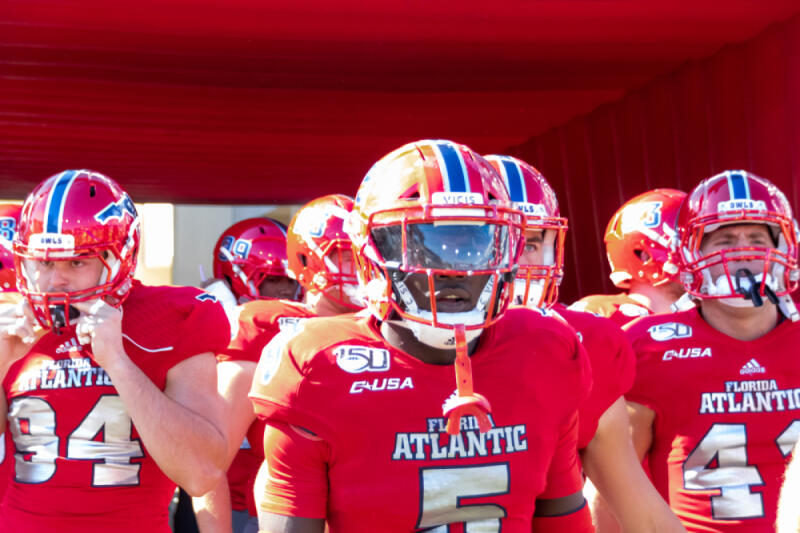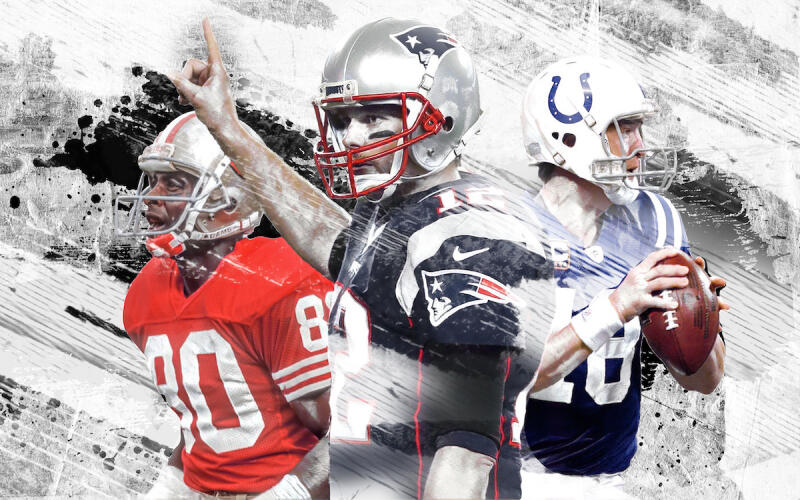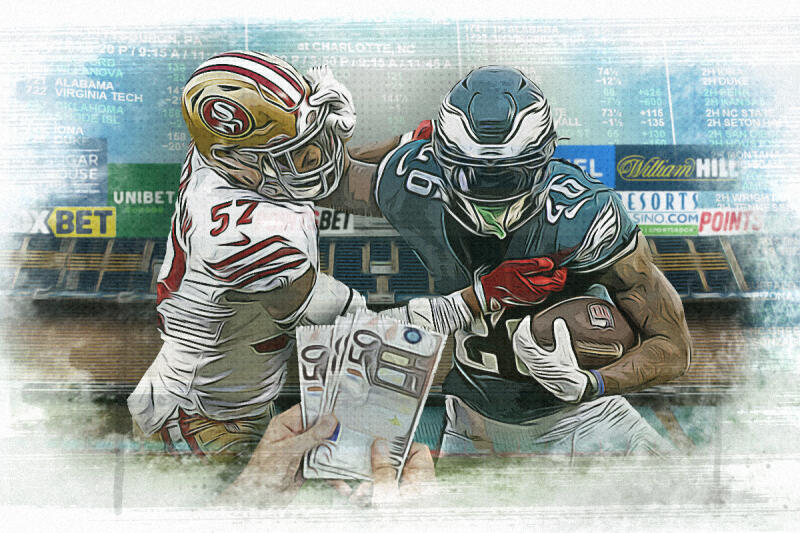The Relationship Between Player Salary and Performance in Professional Sports
If you follow professional sports, chances are you have heard fans and media criticize highly paid players for underperforming. They believe that an increase in player salary should lead to an increase in performance, but is that really the case?
We conducted a study of the NBA and NFL to determine whether a relationship between player salary and performance exists. To do this, two specific areas were researched:
- No. 1: How a player performs before and after receiving an increase in their salary.
- No. 2: How many of the league's top players also own large salaries.
Before diving into the results, let’s start by covering fans' current perception of the relationship between player salary and performance.
Related: Enhance your understanding of the next game with our NFL Predictions.
The Perception of Player Salary vs Performance
The consensus among pro sports fans is that the more a player makes, the better they should perform. If players fail to do that, they are accused of “giving up” or “not caring about winning.” This perception is amplified when it involves contracts that include guaranteed money.
The public often judges athletes as they would employees in the every-day workforce, believing their salary should reflect the effort they put into their job. Employees who work harder will get raises, while those that don’t will be passed over. This is the standard sports fans often have, and it’s the reason those with high salaries draw fierce criticism. That thought process is understandable, but it is not based on facts and numbers.
Measuring Performance vs Salary
Focusing on the NBA and NFL, the relationship between a player’s pay and performance on the field can be measured. Statistical ratings for each league were used to provide the most straightforward comparison between players based on overall play and salary.
Two specific scenarios were used to find answers. The first compares players who have signed massive contracts in recent seasons. A comparison is made between the last year of the old contract and the first year of the new deal. The goal is to establish if an increase in salary led to a rise in performance.
The second scenario involved the average salaries of the top 10 players in each league. A player rating system to establish the 10 best players from the previous season is employed, and then compared to their current average salary.
The Relationship Between NFL Player Salary and Performance
The NFL has dominated the US sports landscape for years, but player contracts still lag far behind those in the MLB and NBA. Guaranteed contracts are also rarer in the NFL, meaning players have to play to get paid, and job security is less than in other pro sports.
While comparisons can be made across multiple positions, we are focusing on the quarterbacks. That is because there are no ratings to compare players across positions, and quarterbacks earn the highest bumps in pay.
We have taken the quarterbacks who have signed the most significant contracts over the last few seasons. We compared their passer rating from the final season of their old contract to the rating from the first season of their new contract. We removed those quarterbacks who recently signed their first big contract, because those players have not played a game under their new deal.
Passer rating combines several stats to give an overall rating. Those stats include passing attempts, completions, yards, touchdowns, and interceptions. This helps encompass a complete picture of the quarterback's season, making it a fairly straight-forwardd comparison for our purposes.
The rules around NFL contracts
While many types of contracts are available in the NFL, the rules around them are quite varied. Rookies sign a four-year deal with a team for an amount of money that is determined by their draft position. Players drafted in the first round will have contracts with a fifth-year team option added, but that must be picked up after the players' third season.
Once the rookie contract is completed, there are no limits to how much money they can make. The player can be signed for the amount teams are willing to pay him.
There is one small caveat to the above, which is the “franchise tag.” This happens when a team wants to keep an unrestricted free agent but can’t negotiate a deal. The team can keep the player for one year and must pay them a salary equal to the average of the top five players at their position.
Performance before and after a new contract

We found the 10 quarterbacks who have signed the largest contracts over the last few seasons. This allowed us to collect data and compile it in a graph to show how their performance changed between the end of their old contract and the beginning of the new one.
All but 2 of the 10 players saw regressions to their passer rating between the final year of their old contract and the first year of their new contract.
On average, quarterbacks in this group saw a 13.48 point drop in their passer rating after signing a new contract. This demonstrates there is some correlation between increases in salary and player performance, just not in the direction that was expected.
Average salary vs overall passer rating
Another way to check the correlation between player salary and performance is by looking at the quarterbacks with the top 10 passer ratings in the NFL last season. This list used only quarterbacks who played in at least 14 games last season. Each quarterback's current average salary is included to see if they are also the highest-paid players.

As you can see, nothing in these results suggests that player salary is related to performance. It is worth noting that Tua Tagovailoa, Joe Burrow, and Trevor Lawrence are all elite young players awaiting their first big contracts. However, Andy Dalton and Geno Smith are both players making less than they did at the peak of their careers, but they still finished above names like Aaron Rodgers, Dak Prescott, and Kyler Murray.
That further suggests no positive correlation between NFL player salaries and performance. If anything, the data points to the opposite being true.
Can the same be said for the NBA?
The Relationship Between NBA Player Salary and Performance
The NBA players have more star power and can command more significant salaries than their counterparts in the NFL. NBA players also have the advantage of guaranteed contracts, which are far more common than in the NFL.
Another way the NBA differs from the NFL is “load management.” Teams strategically rest their best players to prevent injury and keep them fresher throughout the long 82-game regular season. That means that the players with the higher salaries will not play as many games.
While it is challenging to compare players from different positions in the NFL, ESPN’s John Hollinger has a tool to do so in the NBA. He created the Player Efficiency Ratings (PER), which use a detailed formula to establish a player's overall value.
Using the PER rating, we will compare the same two scenarios as we did for the NFL. Looking at the top ten largest contracts signed in the last few years and comparing the player's performance in the first year of it to the last year of their old contract.
The rules around NBA contracts
Before diving into the data, it is vital to understand the different levels of an NBA contract. The league has rigid rules with different levels of contracts a player can receive based on their experience. Unlike the other leagues, teams cannot simply sign a player to a max contract after their rookie year. Instead, the amount of money a player can be paid increases per the time in the league.
The most important factor is the “supermax” contract. As the name implies, this is the most significant contract a player can receive, but it comes with qualifiers. A player must have at least seven years of experience in the NBA and have been named to the All-NBA team the previous season.
Performance before and after a new contract
We have sorted through the top ten most valuable contracts signed before this season, giving us a clear picture of each player's play before and after signing that contract. Using PER rankings, it is fairly straight-forward to establish an accurate value for each player instead of comparing several categories independently. The results were surprising.

Unlike the NFL, this concludes that NBA players improve their play after signing a new contract. This was surprising, as the NBA offers far more guaranteed money than the NFL. That should take away some incentive to perform at a high level, but instead, 70% of the players on this list improved their PER after signing a new contract.
You may notice names like Joel Embiid and Nikola Jokic missing, but that is because they have signed new contracts that kick in next season. We also took out players – including Zion Williamson – who failed to play in at least 50 games this year.
Average salary vs PER
What follows is an examination to see if the league’s highest-paid players are indeed the best in the league. We have reviewed the PER rankings and selected the top 10 players who appeared in at least 50 games. They have been ranked in order and measured the salary for each.

These results also differ significantly from the NFL. Each player on this list is considered among the most valuable in the league and is paid accordingly. It is also worth mentioning that Jimmy Butler, Jokic and Embiid all signed massive new deals that will move them into the $40-$50 million range. Shane Gilgerous-Alexander is still young and just had his breakout season, so his next contract is expected to put him close to the other stars on this list.
These studies suggest that the NBA does have a positive relationship between player salary and performance.
What About the MLB?
We originally set out to research the relationship between player performance and salary for all four major US sports, but the MLB is too unique to get a fair comparison.
The MLB is difficult primarily because of how their contracts work. Star players will sign lengthy deals for huge sums of money, meaning they may only sign a couple of contracts throughout their careers. The wide range of years makes it hard to compare performance between contracts, especially since some last well past the player's prime years.
Comparing players statistically is also tricky, as it’s hard to assess a slugging first baseman against a speedy center fielder. The MLB uses Wins Above Replacement (WAR) to rank players based on how many wins they add compared to a replacement player. The issue with using it as a tool for comparison is that it relies on how many games are played, meaning that it is greatly impacted by injuries.
While we can’t compare these as efficiently to the NBA and NFL, we know it isn’t uncommon for players who sign massive contracts to face huge drops in production suddenly. Players like Anthony Rendon, Christian Yelich, and Juan Soto are recent examples, as all three have significantly regressed after signing huge guaranteed contracts with their teams.
Conclusion
After comparing the NFL and NBA, we were surprised at the results. Given the difference between the contracts, we expected the NFL to have a closer link between increased pay and increased performance, but the opposite was true.
Research into the NFL showed us that players in that league are more likely to see a regression after signing a large contract. This is surprising given that they are the only league where guaranteed contracts are uncommon, meaning an injury or decrease in performance can cost them a lot of money. We also saw that the top performers from last season included several lower-salary players. This leads us to believe that NFL salaries are more of a reward for past play instead of an incentive for future performance.
When looking at the NBA, the opposite appears to be true. After signing a new deal, we saw that most of the league's highest-paid stars improve in the first year of their new deal. While this is an interesting trend, it could also be seen as a result of the shorter-contract lengths common in the NBA. Players enjoy the freedom of moving between teams, leading many of the top players to look for shorter contracts instead of pursuing a supermax deal. However, when you look at how the top players from last season were paid, you can see a strong correlation between performance and salary. Each player was making the maximum amount allowed, with no surprise names finding their way onto the list. This suggests a stronger link between salary and performance despite those contracts being mostly guaranteed.
In conclusion, the perception that a pro athlete's salary is tied to their performance is mostly false in the NFL but does carry some truth in the NBA. While perception around high-paid athletes will likely never change, the numbers give us a clearer picture of the reality.
Our editorial content strives to be highly informative and educational to our audience, especially for visitors who are new or relatively new to analyzing and predicting sporting event results. All of our content is created by informed writers with backgrounds in their subject area and reviewed for omissions or mistakes.
Our editorial team is run by individuals with many years of experience in digital publishing, editorial, and content production. Our editorial content is always marked clearly in any instances where it may be sponsored by a third party, though it is still reviewed by our staff to ensure it remains consistent with our company mission.
- Popular
- Latest





